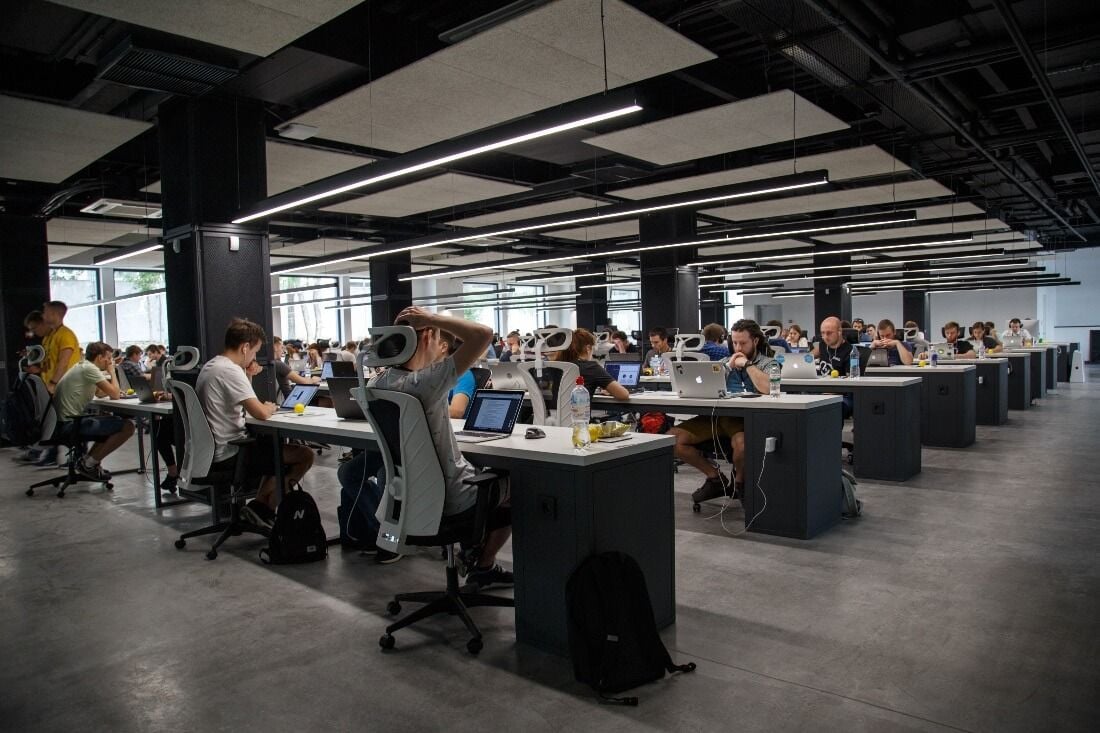In the past few years, the term hot-desking has become increasingly popular in the workplace. In this post-pandemic world, thanks to the flexibility that hot desking allows both companies and their employees, it seems as if hot-desking and other hybrid-style offices could become the norm compared to the typically fixed allocation desks and cubical office-type layout.
If you’re trying to decide whether hot desking is the right decision for your company, or if you, as an employee will suit a hot-desking work environment, then this article is for you. You’ll discover that many employees thrive off the flexibility and freedom that hot desking provides, whilst others miss the sense of community that can come with set desks and department floors. You might be surprised to find that despite the lower costs and productivity benefits for employers, it isn’t always the best choice for every company.
We’ll explain what hot desking is and where it came from, and then delve into the advantages and disadvantages of hot desking. Finally, we’ll help you decide whether hot desking is best for your situation to reach your business goals.
What is hot desking?
Looking to the Oxford Dictionary for clarity, the definition of hot desking is defined as:
‘the practice in an office of giving desks to workers when they are required, rather than giving each worker their own desk’ - Oxford Dictionary
In other words, hot desking is when each employee does not have a set desk or cubicle, instead, each day they work at a different desk in the office. These desks can either be assigned on a first-come, first-serve basis, by zones, or by using a desk booking system.
Hot desking was invented in 1993, when a Chicago branch of an IBM unit began using the concept. It was apparently inspired by the hotel business in the 1990s, with a Chicago-based IBM business unit first utilising the concept. However, the official date of invention is up for debate, with others claiming it was invented in the 1980s.
Advantages And Disadvantages Of Hot Desking
Like many things in business, hot desking has it’s advantages and disadvantages. Let’s first examine the advantages of hot desking, for both employees and employers.

What are the benefits of hot desking for employees?
The absence of a regular desk leads to employees being more likely to move around the office and talking to different team members they might not normally interact with which can lead to boosted levels of collaboration. This is especially beneficial if the team utilises a hybrid-model where employees can work from home on certain days.
2. Sense of freedom
Studies show that one of the primary factors leading to enhanced job satisfaction is a sense of autonomy over their job. Hot desking can provide employees with an extra level of control they feel they didn’t have when previously being assigned a workspace.
3. Boosted Productivity
This particular advantage of hot desking is up for debate. Although some studies show that hot desking can increase productivity among team members, others demonstrate the opposite. In fact, a recent study found it to be almost an even split. 56% of employees felt hot desking boosted their productivity levels while 46% didn’t agree!
4. Tidier Offices
By not being able to leave their belongings all over the desk each night, hot desking promotes a cleaner, more organised workspace which can benefit everyone. After all, you know what they say, tidy desk, tidy mind!
What are the advantages of hot desking for companies?
Companies love the fact that hot desking can make the most of a smaller space and reduce real estate costs.
In addition to saving money and boosting profits, companies enjoy the way hot desking helps integrate newer team members, freelancers and contractors into a workspace.
Finally, as hybrid working has become the norm, employers want to change how their offices are used to promote more collaboration. Hot desking gives the most flexibility for teams or projects to gather together and collaborate when they are in the office together.
What are the disadvantages of hot desking?
Although there are plenty of advantages to hot desking, there are of course, the disadvantages, let’s take a look at these now.
- Drops In Morale
By taking away a person’s right to decorate their desk with family photos or house plants, employees could feel like they are becoming just a wheel in a cog and lose that sense of belonging. This can have dire consequences for employees job satisfaction, with drops in morale and motivatio, leading to lower retention levels.
2. Lack Of Community
Feeding off of a lack of belonging, hot desking can also divide previously united teams and departments and foster a sense of loneliness within in the workplace. Communities are built when employees sit together daily, building habits and routines together.
3. Time Waster
When an employee is forced to spend 20 minutes hunting down their employee in the building only to find they aren’t actually in the office can lead to a drop in productivity. Fortunately, there are hybrid working tools that can notify you when team members plans change and they are no longer planning to be in the office.
4. Hot Desk Anxiety
Finally, there is such a thing as hot desk anxiety where people who suffer from social anxiety find it stressful not knowing who they might be sat next to the next day. Many employees enjoy the routine that work brings, and they could find it hard having to engage in small talk with near-strangers each day.
Can Hot Desking Be Successful?
It’s clear to see that hot desking has a place in the workplace but its not for everybody. Making hot desk a productive venture depends entirely on the company, what may work for one company might not work for another.
If your company is keen to rethink how it uses its space with hot desks, then it will fall to the leadership team to successfully implement and monitor how it goes.
There needs to be discourse around how to adapt the company’s culture to this way of working, as well as establishing rules around hot desking best practices. It is will be particularly important to get feedback from different levels of management right down to the junior members of staff. Companies will also need to consider how they can nurture a sense of belonging and community that can get lost with the anonymity of hot desking. Hybrid work planning tools like DuoMe can be part of the answer here.
There are plenty of companies that have shown hot desking can be a success, usually when it combines with other innovative work concepts such as the hybrid work model or flexible working. In order to make hot desking work, companies will need to ensure that there are proper systems in place to adjust to the change.
Is hot desking the future?
Whether or not hot desking is currently a success does not change the fact that it’s here to stay and will most likely become the norm rather than the outlier as we grow into our hybrid working future.
Thanks to current economic conditions, companies, more than ever, are looking for cost-effective solutions and ways to save money, and one of those ways is hot desking.
About Author
Graham Joyce is co-founder of DuoMe, a flexible working advocate and a frequent panellist/commentator on the issues of flexibility or hybrid working.







